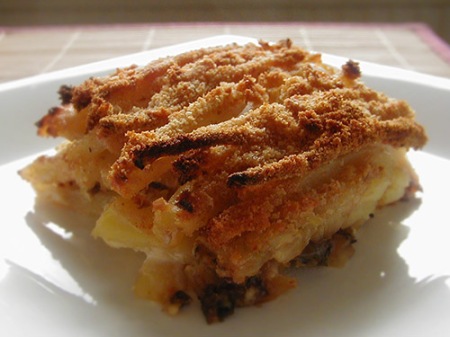
Ingredients: potato, onion, cream, butter, bread crumbs, Swedish pickled sprats
Janssons frestelse (Jansson’s Temptation) is a curiosity of Swedish cuisine. What a strange name! And such strange flavor to boot. But for the locals, this potato casserole is pure husmanskost — comfort food, home cooking. No smörgåsbord (traditional Swedish buffet) is complete without Janssons frestelse, especially around Christmas time.
The name Janssons frestelse is actually a reference to a Swedish movie from 1928, which was popular at the time of the dish’s invention. I find it funny because “temptation” implies that the casserole is some kind vice, in the vein of Chocolate Sin Cake. Janssons frestelse certainly does require a boatload of cream to make, and is otherwise a giant pile of carbs, but I don’t think such things have ever been considered sinful here (or anywhere else in Europe). The name was catchy though, and has persisted long after the movie was forgotten.
Texturally, this dish is pretty similar to a cheesy potato gratin. Tastewise, I can think of no comparison. The unique flavor profile comes from ansjovis, which you might think means “anchovies.” You’d be wrong, but you’d be in the warm company of hundreds of semi-tragically mistranslated recipes. An ansjovis is a fish, but tastes nothing like French/Italian anchovies. It’s a type of herring, and it’s sold pickled in tins with a very specific spice blend, including white vinegar, sugar, salt, cinnamon, allspice, bay leaf, ginger, clove, and sandalwood. See, I told you there was no comparison!
To make a Janssons frestelse is very simple. Open a tin of ansjovis (which you can actually find for sale in the commissary at IKEA) and mix the brine with 2 cups of cream (or a mixture of milk and cream). Fill a casserole by alternating layers of shredded potato, ansjovis fillets, and thinly-sliced, skillet-browned onions. Pour in the seasoned cream, not quite filling the casserole but close enough so that the potatoes can soak it up. Then sprinkle bread crumbs all over, followed by a drizzle of melted butter. Bake for an hour.
I can understand someone not caring for Janssons frestelse, but to my foreigner’s palate, it’s absolutely delectable. There is no taste of fish whatsoever, just a pleasant savory fullness. In fact I love the vibrancy that happens as my tastebuds try to figure out whether or not this is a dessert.
Another nice thing about Janssons frestelse is that it tastes just as good from the fridge as it does from the oven – surely the mark of a great casserole!
